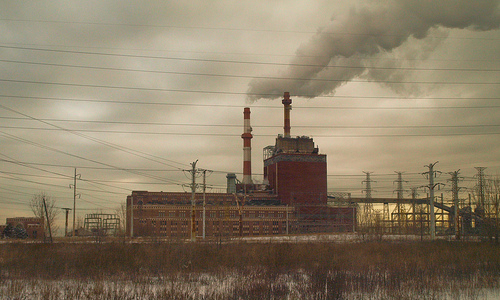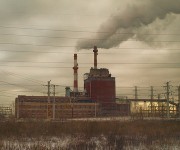 Chicago’s State Line Power Station is shutting down.Photo: contemplative imagingEverything is about jobs in D.C. these days, at least rhetorically. The latest line of attack from the dirty-energy caucus has been that “54,000 direct jobs” will be lost if, as expected, new EPA regulations lead to the shuttering of around 20 percent of the U.S. coal-power fleet. For some state-of-the art agit-prop, see the website of one J. Inhofe.
Chicago’s State Line Power Station is shutting down.Photo: contemplative imagingEverything is about jobs in D.C. these days, at least rhetorically. The latest line of attack from the dirty-energy caucus has been that “54,000 direct jobs” will be lost if, as expected, new EPA regulations lead to the shuttering of around 20 percent of the U.S. coal-power fleet. For some state-of-the art agit-prop, see the website of one J. Inhofe.
Put aside the fact that the jobs figure came from a consultant to a dirty-energy advocacy group and is almost certainly overstated. (The numbers they’re tossing around for the total impact of EPA regs are even more ridiculous.) Even if it’s nowhere near that number, there will in fact be jobs lost when that 20 percent of coal plants shut down. So let’s talk about that.
The key thing to remember is that these are some of the most heavily subsidized jobs in the U.S. economy. They are subsidized at a level that makes anything Obama did with the stimulus bill look like pocket change.
Why is that so? Well, it’s widely known by now, at least in economist circles, that the coal power industry grossly underpays for the damages it does. That’s the unanimous conclusion of a flurry of new research that’s been done on the question: see, e.g., the National Research Council (NRC), Harvard Medical School’s Paul Epstein, or last week’s bombshell from Yale’s William Nordhaus and colleagues, which found that coal-fired power plants do something like 5 cents of unpaid damages for every single kilowatt hour of power they produce. Economists call these costs “externalities,” but really they amount to subsidies — the public is paying these costs on the coal companies’ behalf.
What’s perhaps not as well understood is that the bulk of those damages comes from a relatively small number of extremely dirty plants, the ones that still burn high-sulfur coal or lack pollution-control equipment. The NRC report found that the 95th percentile of coal plants do more than 24 times the damage of the fifth percentile, on a per-kW basis. It is those plants, the clunkers that are just barely (or not even) economic to run, the ones grandfathered in under the Clean Air Act [PDF], that will be picked off by new regulations.
Over the past few months, several of those plants have begun to shut down:
- in April, TVA announced it would take 18 coal-fired plants offline;
- Virginia-based Dominion announced in May that it would close State Line Power Station in Chicago and in September that it would close Chesapeake Energy Center and the Yorktown power plant;
- Midwest power giant AEP announced in June that it would shut down five aging coal plants;
- in August, the city of Alexandria announced it would soon close the Potomac River Generating Station;
- last month, Dallas-based Luminant said it would shut down two units in its Monticello plant;
- also last month, Louisville Gas & Electric announced it would shut down its Cane Run, Green River, and Tyrone coal plants and replace the lost capacity with a cleaner burning natural gas plant.
Unsurprisingly, power companies and conservatives are conspiring to pin this on EPA. Of the AEP retirements, Rep. Shelley Moore Capito (R-W.Va.) said, “This is a perfect example of the EPA implementing rules and regulations without considering the devastating impact they may have on local economies and jobs.” Louisville Gas & Electric’s CEO warned of “significant impacts” to Kentuckians. Luminant is outright suing EPA.
But let’s pause there for a second, on Luminant. The Monticello plant that the company is shuttering is 33 years old. It is facing increasing competition from wind and gas. Its revenues are declining. It is saddled with crippling debt. And it is filthy. I direct your attention to a recent Sierra Club report: “The Case to Retire Big Brown, Monticello and Martin Lake Coal Plants: Three Mismanaged, Unprofitable, Outmoded and Worthless Coal Plants in North Texas” [PDF]. From the press release:
Big Brown, Monticello, and Martin Lake are three of the worst polluters in Texas accounting for over 25% (over 400,000 tons a year) of all industrial factory air pollution in Texas. That’s out of nearly 2,000 industrial plants. They also account for about 50% of all coal plant pollution. These three coal plants alone emit almost 4,000 pounds of mercury into the air every year, over 180,000 tons of sulfur dioxide, over 30,000 tons of smog-forming nitrogen oxides, and millions of tons of carbon dioxide, the principal greenhouse gas. All of those emissions are carried into the Dallas/Ft. Worth area and then up into Oklahoma to Oklahoma City.
In short, Monticello was a creaky old jalopy, running on fumes. The only way it was kept alive so long is that the public — particularly the public in the Dallas/Ft. Worth area — subsidized it to the tune of millions in health and employment costs every year. That’s the price of the jobs that Capito, Manchin, Inhofe, and others like them are romanticizing: they exist because the public absorbs their externalized costs.
I don’t have the spreadsheet chops to tally up all those costs and calculate a per-job subsidy (if there are nerds reading, get on this!). But it’s clear from the numbers that it’s big.
And these subsidies are not investments that pay back over time, like loans to innovative renewable energy firms. These subsidies come in the form o
f babies with birth defects, asthmatic kids, and adults with respiratory and heart ailments. These subsidies pay negative returns. They subtract value. All in the name of propping up a dying industry.
Why, in an economy that is struggling to emerge from a recession, not to mention a decades-long stagnation, should we pour hundreds of millions of dollars of subsidies into a relatively small number of jobs in coal plants that are already living on borrowed time and unpaid debt? Why is that the way we choose to do economic stimulus?
It is true that jobs will be lost when these rattle-trap death factories get shut down. Those who lose their jobs deserve respect and assistance. But it’s just as true that lives will be saved, public health and well-being will be improved, and the economy as a whole will benefit. The dead weight of this subsidized power will be lifted and newer, cleaner sources will compete to fill the gap, creating jobs in the process.
Americans paying other Americans to sicken and kill them is no way to fight unemployment.


